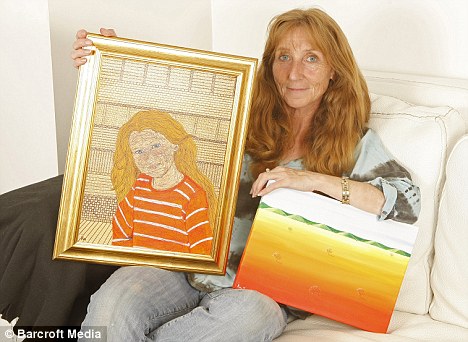
For those that aren’t familiar with the term “Multiple Personality Disorder” or the more clinical label “Dissociative Identity Disorder”, I am glad to fill you in direct from the Wiki.
Dissociative Identity Disorder (Multiple Personality Disorder): a psychiatric diagnosis and describes a condition in which a person displays multiple distinct identities or personalities (known as alter egos or alters), each with its own pattern of perceiving and interacting with the environment. Each sub personality or alternate personalities have a unique set of memories, behaviors, thoughts and emotions related to each specific personality.
While several people have claimed this disorder, few have had as many distinct and seperate personas as the following woman.
Kim Noble of London, England has suffered with “DID” her entire life and can remember episodes from early childhood. It took years of turmoil and tramatic events until Kim was finally diagnosed correctly with the help of trauma therapist Dr. Evelyn Laine in the mid 90s.
It was discovered that Kim had at least 20 different personalties trying to control her. That’s 4 more than Sybil if your counting. If Kim’s life was anything close to the woman that Sally Field played in the movie then my hat’s off to her for still being alive and raising a child.
Here’s more on Kim’s ordeal from The Daily Mail:
The woman with 20 personalities in one body: An anorexic teen and a boy who writes in Latin. They all take over Kim’s mind in a case that’s baffled experts
Split personalities: Kim Noble has Dissociative Identity Disorder which means she switches from one character to another without warning
Split personalities: Kim Noble has Dissociative Identity Disorder which means she switches from one character to another without warning
The entire class fell silent as the teacher, Mrs Baldwin, marched across the room. ‘Kim Noble, stand up!’ she barked, grabbing the bewildered five-year-old’s arm. ‘What did you do that for?’
The little girl looked down at her blouse and skirt. They were covered in splotches of black paint.
‘Of course, the teacher was exasperated when I denied doing it,’ recalls Kim, now 51 and with a daughter of her own, ‘because she’d seen me smear it over myself. But as far as I was concerned, it was somebody else who’d done it.’
What Kim couldn’t have known then was that she was suffering from a rare condition called Dissociative Identity Disorder (DID) — more commonly known as ‘split personality disorder’ — and that over the next four decades, her mind would regularly switch from one character to another without warning.
The most consistent of Kim’s personalities is called Patricia, and she is the narrator of an intriguing new book called All Of Me, which attempts to piece together Kim’s extraordinary, chaotic life.
In fact, Kim Noble no longer really exists. She explains: ‘To most of the outside world I am Kim Noble, and I’ll answer to that name. But the truth is her mind shattered into fragments before she could even talk, leaving numerous alter egos to take over.’
Today, there are more than 20 alter egos who can appear at any given moment. Alongside the sensible, no-nonsense Patricia, there’s Abi, who’s single and desperately looking for love, Bonny, a mother with a young daughter, and Salome, a devout Roman Catholic. There’s a little boy called Diabalus who only writes in Latin, and a depressed twenty-something called Ken.
Truly, this is a story that stretches credulity to its limit. But Kim’s extraordinary case has been studied closely by therapists and doctors, who are convinced she is not a fantasist and is genuinely in the grip of forces beyond her conscious control.
An alter ego called Patricia has been her dominant personality now for more than six years. Patricia runs the household, takes primary care of daughter Aimee, now 14, and does her best to make sure mother and daughter live a normal family life. But even on a good day, two or three other personas will take over completely and do whatever they want while in control of Kim’s body.
When a switch happens, it’s literally as though someone else slides into Kim’s skin. Her face twitches as the eloquent, rational Patricia gives way to mischievous Judy, a self-conscious 15-year-old who often appears at mealtimes. Judy is always bemused by the frumpy clothes she is wearing and immediately wants to get changed.
‘Sometimes, I can end up wearing five different outfits in one morning,’ explains Patricia.
‘Normal for me is driving to the shops and returning home with my boot full of groceries I didn’t want,’ she writes. ‘It’s opening my wardrobe and discovering clothes I hadn’t bought, or taking delivery of pizzas I didn’t order.
‘Coming back after a personality switch is like waking up from a nap. It takes a few seconds of blinking and looking around to get my bearings, to work out who I’m with, where I am, and what I’m in the middle of doing,’ she says.
‘I could disappear from my sofa and wake up at a pub, or a supermarket, or even driving a car without a clue where I’m heading.’
Usually, in those suffering from DID, the dominant personalities have some awareness of the other characters: maybe they hear voices or they can see what is going in even when they’re not in control.
But with Kim’s condition, there is no ‘seepage’ between the personalities. They operate independently of each other — sharing the same body but none of the same experiences.
This would explain the incident with the paint at school. Patricia believes that another more mischievous character threw the paint, and she was left to pick up the pieces with no knowledge of what had gone on just seconds before.Some of the characters seemed to be inextricably linked to episodes in Kim’s life — even though she has no memory of them. Take Dawn, who is looking for her baby — an echo, surely, of the traumatic moment in Kim’s life when her baby was taken away at birth by social services because of her history of mental health problems.
Most experts agree that DID is triggered by severe trauma, and it seems as though Kim’s mind constantly compartmentalizes itself to cope with painful life experiences.Others are arrested in time. Like the teenage Judy, who has an eating disorder — just as Noble did when she was a young woman.
But it is Ria, a 12-year-old girl, who probably holds the key to what triggered this bizarre disorder in the first place. Ria continually paints disturbing pictures showing children being bullied and abused.
Kim, who has no recollection of any abuse, may never know the truth. It may be just too painful for her to comprehend. But it seems certain that she suffered great trauma in very early childhood.
Kim undergoes intense therapy sessions in order to face up to what has happened in her life, and to reintegrate the personalities so that she can finally live as one person.
But for now, it is Kim’s rational self, Patricia, who is running the show, and she copes by viewing the other personalities as permanent house guests. She leaves notes for them, and several have email accounts so she can contact them that way.
She has even managed to draw some positives from her disorder, for today she is a successful artist, exhibiting the (very different) works produced by a number of her alter egos.
Her daughter Aimee, meanwhile, in the way of children, has grown up to regard her mother’s various personalities as entirely normal. So much so, she even has her favorites.
Aimee was taken into care for six months when she was a baby, but the psychotherapists treating Kim helped her to appeal against this decision on the grounds that none of the personalities was a threat to the child. Since then, Kim has been able to raise her daughter with the support of therapists and social workers.
When Kim was a child growing up in Croydon, South London, life was confusing and frightening as she was constantly switching between different personalities. Her parents James and Dorothy Noble, who worked in the computer industry, seemed to have largely ignored her bizarre behavior, putting it down to naughtiness.
But when Kim hit puberty, other far more disturbed alter egos starting making regular appearances — such as Rebecca, who was suicidal, Sonia, who was anorexic, and Judy the bulimic teenager who binged on shredded paper.
Kim was first referred to a psychiatrist at 14, and spent much of her late teens in various homes for ‘troubled’ teenagers until she was mistakenly diagnosed with schizophrenia in her early 20s.
‘Aimee is not just my number one priority. All the personalities love her – which is why Christmas and birthdays are such fun. It’s not unusual for Aimee to get presents from a dozen of us.’Kim was sectioned, put on strong antipsychotic drugs and told she was likely to remain in Muse Treatment rehab for at least the next six years.
But she instinctively knew it wasn’t the right diagnosis — and, sure enough, her mind came to the rescue by allowing another alter ego, a bolshie young woman called Hayley, to become dominant. Hayley appealed against the ward of court order and won.
Once out of hospital, Kim’s problems were far from over, however. For the next few years, three dominant characters were competing for control of her body — Hayley, the feisty one, Bonny, the maternal one, and Patricia, the sensible one — and depending on which alter ego was in control, Kim found herself living in totally different parts of London.
This part of her life sounds almost too far-fetched to be true. But Noble claims she has since found letters addressed to Hayley and Bonny, and that at one point she was dividing her life between three different homes.
It sounds implausible, and even Noble cannot convincingly explain the logistics; but then we are not talking about an ordinary life.
Some may struggle to believe that Kim’s personalities have no awareness of one another, but Graeme Galton, a consultant psychotherapist at the Clinic for Dissociative Studies in London, says it is perfectly possible.
He has never treated Kim but has encountered patients with her condition. He says: ‘Dissociative identity disorder is a complex post-traumatic stress disorder. The purpose, psychologically, is to protect the mind when a traumatic event has taken place.
‘To do this, the mind splits off the memory of the trauma into a separate identity. That means that, in its most original and true form, there is an amnesiac (memory) barrier between different personality states, although some people can develop flashbacks or nightmares.
‘People may just have two or three personalities, but I work with some individuals who have an enormous number. Sometimes people who have experienced multiple trauma, especially as children, have separate identities for every traumatic incident.’
Noble’s personal life became even more complicated when she fell pregnant. She believes the father was Patricia’s on-off boyfriend — but insists she has no memory of the pregnancy, or the birth in 1997.
Again, it seems that her inbuilt defense mechanism kicked in — this time in order to protect her from the pain of her child being removed from her care within hours of the birth. This traumatic event is remembered by only one personality, a troubled woman called Dawn.
Another personality, Bonny, then took over, and Bonny considered herself to be Aimee’s mother when the child was small. Kim was only able to piece all this together years later, with the help of therapists, when she was finally diagnosed with Dissociative Identity Disorder in the mid-1990s.
‘From the moment I (Patricia) became the dominant personality, I promised I would discover as much as possible about the life — or lives — of Kim Noble. After so much confusion, I needed to have the facts, however unpalatable.
‘But trying to tell this story when, for a lot of my life, I was only around for a fraction of a day at a time, has been hard.’ She began to put together the pieces of the puzzle with the help of trauma therapist Dr Evelyn Laine.
‘It was Dr Laine who told me about a woman called Hayley and another called Bonny, two personalities that had previously been dominant and whom she’d met in therapy sessions.
‘I recognized both names instantly. I’d seen letters addressed to both at my house, and had wondered who they were. She also helped me to face up to another truth — that Aimee was my own daughter.’
The little girl was returned to Kim Noble’s care at six months, and has, with close monitoring from social workers, remained with her since.
‘Aimee saw from a very early age all the different personalities coming out of Mama,’ says Kim. ‘She learned, almost subliminally, to accept each and every one of them as a person in their own right.’
Confusing though it may be at times, Kim stresses that there are unexpected benefits too. ‘Aimee is not just my number one priority. All the personalities love her — which is why Christmas and birthdays are such fun. It’s not unusual for Aimee to get presents from a dozen of us.
‘They all shop for gifts themselves. I can’t complain, even when I see my money disappearing. After all, it’s Kim Noble’s name on the credit cards, not mine. They’ve as much right as anyone to spend it.’
It was thanks to Aimee that Kim discovered the healing powers of painting. What started as a fun thing to do with her daughter proved to be a powerful way for many of her personas to express themselves.
Thirteen of Kim’s alter egos now paint, and Kim often wakes up in the morning to discover a new work she has no recollection of creating.
‘By introducing painting into our lives, I’ve actively helped to steady the ship,’ she says.
‘According to Dr Laine, our lives have never been less chaotic. Painting seems to provide an alternative outlet for some of those with suicidal thoughts, and in other cases has just made the rest of us strong enough to resist.
‘And Dr Laine says Aimee couldn’t be in better hands. She was even voted Head Girl at her school.’
Kim, meanwhile, is winning plaudits for her art. ‘Our first exhibition at a gallery in Hampstead was such an emotional experience. Seeing all our paintings hanging side by side took my breath away.
‘I realized that part of every personality was up there. It was the nearest thing to integration we will get.’
Source: The Daily Mail
Warning: We are in no way judging Kim Noble’s artwork, however some of the content on her website is extremely explicit and not recommended for children under the age of 18.
5 comments






